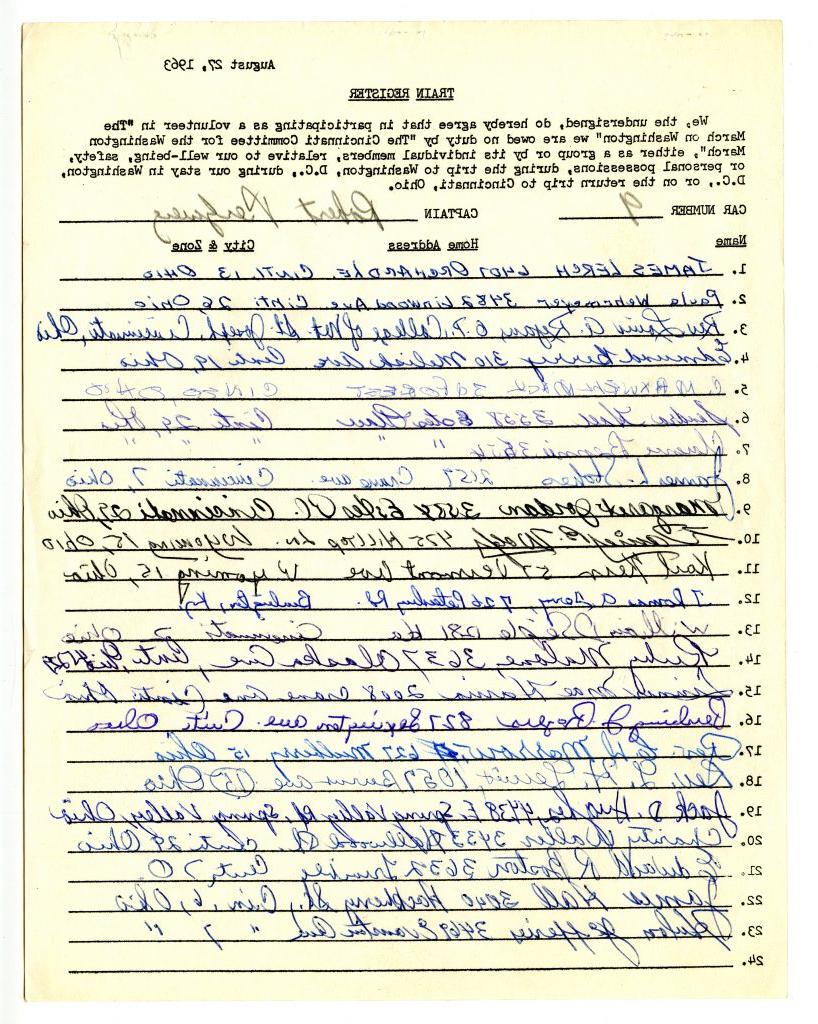
CMC的博客
The 华盛顿三月特辑: Cincinnati Marches on Washington
By: Christine Schmid Engels, Manager, Archives and Manuscripts
On the evening of 外胎day, 8月27日, 1963, a train pulled out of Cincinnati’s 结合终端 with 497 of the region’s leaders and supporters on their way to the March on Washington for 工作 and Freedom. Organized on a national level by Bayard Rustin (1912-1987) and A. Philip Randolph (1889-1979), 这些要求包括, “meaningful civil rights laws, massive federal works program, 充分和公平就业, 体面的住房, 选举权, and adequate integrated education.”[i]
People from all over the country organized on a local level to get there. Cincinnati branches of several organizations including the National Association for the Advancement of Colored People [NAACP], 城市联盟, the Congress of Racial Equality [CORE], and countless churches worked together to get everyone there. 牧师. L. 理查德。 Hudson led the Cincinnati delegation and was able to get round-trip tickets for $20 (nearly $200 in 2023) from the Chesapeake & 俄亥俄州的铁路. The train was known as the 华盛顿三月特辑.[ii]
Though countless people worked to make the trip a success, some key players were Clyde W. Vinegar (1927-2005), President of CORE; Joseph A. Hall (1908-1998), Executive Director of the Cincinnati Branch of 城市联盟; and Rev. 理查德·D. Isler, Executive Director of the Council of Churches of Greater Cincinnati. Each of Cincinnati’s four Black City Council candidates were present on the train: Theodore Berry (1905-2000), Charles Collins (1901-1970), 布福德·康利(1928-1963), and Webster Posey (1912-1997). The Council of Churches of Greater Cincinnati wrote a letter to Protestant clergy and urged them to join the march. 超过40岁, as well as at least two priests and two rabbis after Catholic and Jewish leaders also encouraged support of the march and its goals.[3]
After the march local leadership was able to transfer the enthusiasm into action for Cincinnatians’ concerns at home. Countless organizers worked to keep the momentum up for the Freedom March to Fountain Square on Oct. 27, 1963. Their goals were similar to the national demands, including fair housing and employment, school and police integration, a stop to the use of dogs by the police, and passage of a federal civil rights bill. [iv]
National events like the March on Washington often take up such a large space in collective memory that it’s easy to overlook the people who organized in ways large and small all over the country to make it happen. 列车登记表, which each passenger signed and wrote their addresses on, invite you to look more closely at those individual stories. You can see the different handwriting, 各种色调的墨水, and holes left over from staples as pages were torn off and added together as organizers kept track of everything. Sometimes the paper itself tells a story that goes beyond the words written upon it.


An example of the train register, 8月. 27, 1963. 海量存储系统(Mss)中774, 框5, 文件夹35; CMC.


"Voice of Freedom" was a newsletter of the Cincinnati Branch of the NAACP. 海量存储系统(Mss)中774, 框5, 文件夹35; CMC.

Cincinnati B'nai B'rith Grand Lodge 2 urging support of the March on Washington. 海量存储系统(Mss)中774, 框5, 文件夹35; CMC.

Receipt of funds collected for train fair. Mss774, 框5, 文件夹35; CMC
To learn more, please visit the online catalog of CMC’s 辛辛那提的历史 Library and Archives.
http://searchcollections.hatchingit.com/public/archive/Portal/Default.aspx?lang=en-US
http://research.hatchingit.com/librarylinks/archives/mss700-799/Mss774-register.pdf
[i] 摩天观景轮, Cincinnati Committee for the Washington March, Cincinnati Chapter of the NAACP Records, 海量存储系统(Mss)中774, 框5, 文件夹35, 8月. 28, 1963.
[ii] “350 Book Passage on ‘March Special’,” Cincinnati Enquirer, 8月. 23, 1963.
[3] 罗伯特·P的信. Beck, Council of Churches of Greater Cincinnati, to Fellow Clergymen, 8月. 5, 1963, Mss VF 4509; Webb, Robert, “The Great March,” Cincinnati Enquirer, 8月. 22, 1993; “Catholic Bishops Urge End to Racial Discrimination,” Cincinnati Enquirer, 8月ust 23, 1963.
[iv] Seitz, Ed, “Rights Rally Biggest in City’s History,” Cincinnati Enquirer, Oct. 28, 1963
博物馆小时
星期四至星期一开放
10 a.m. 到5点.m.
关闭 外胎day and Wednesday
关闭 Thanksgiving Day and Christmas Day
Member’s-only early entry: 星期六早上9点.m.
客户服务时间:
周一至周日,上午9点.m. 到5点.m.

